
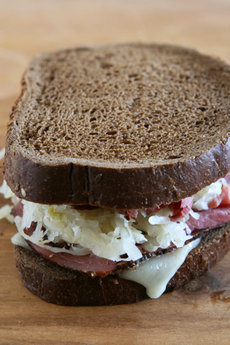 The Reuben sandwich combines corned beef or pastrami with sauerkraut and melted Swiss or Munster cheese. Photo © J.Java | Fotolia.
The Reuben sandwich combines corned beef or pastrami with sauerkraut and melted Swiss or Munster cheese. Photo © J.Java | Fotolia.
September 2009
Last Updated August 2025
|
 |
Different Sandwich Types
Sandwich Glossary Page 5: Sandwich Types R ~ Z
This is Page 5 of a five-page glossary. Terms include recetas, Reuben sandwich, sandwiches de miga, sloppy joe, and submarine/torpedo sandwich. Click on the black links below to visit other pages. Also see our Bread Glossary and many other food glossaries.
RECETAS SANDWICH
See Cuban sandwich.
|
REUBEN SANDWICH
This sandwich dates to the late 1920s, but no one can solve the hotly contested origin. Most evidence points to Reuben Kulakofsky, a Lithuanian-born grocer and resident of Omaha, Nebraska, who created the now-classic sandwich for his poker pals who had a regular poker game at the Blackstone Hotel. The hotel owner liked it so much he put it on the menu. Native New Yorkers firmly believe that credit goes to Arnold Reuben, owner of a deli on 58th Street between Madison and Park Avenues, in 1928. But either way, a Reuben is a grilled or toasted sandwich on rye or pumpernickel with generous amounts of corned beef or pastrami, sauerkraut, Swiss cheese, and either Russian or Thousand Island dressing. There are regional variations, for example, substituting turkey and cole slaw for pastrami and sauerkraut, but the basics consist of a meat, a slaw, a cheese, and a dressing. (See photo at top left.)
|
|
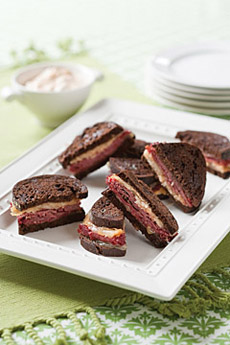
Baby Reuben sandwiches make great snacks. Available from MackenzieLtd.com. |
In 1956, Fern Snider, a cook at the Blackstone, entered the Reuben recipe in the first National Sandwich Idea Contest sponsored by the Wheat Flour Institute, where it took top honors and won her a trip to New York—where she most likely did not eat at Reuben’s Deli, but that information is lost to history).
National Reuben Day is celebrated on November 17th.
The history of the Reuben sandwich.
SANDO
A sando is the shortened form of the Japanese word for sandwich, sandoicchi (itself derived from the English word). Popular flavors are the ebi furai sando (shrimp sandwich, fruit sando, katsu sando (breaded pork cutlet, tonkatsu, in photo) sandwich, and tamago sando (egg salad).
The sando has gained traction internationally, as social media has taken to the crisp, aesthetically pleasing Japanese style.
|
|

A katsu sando, wwith fried pork. Here’s the recipe (photo © SAQ). |
SANDWICH COMPONENTS
A sandwich is composed of four parts: the bread, spread, filling, and garnish.
|
SANDWICHES DI MIGA
These Argentinean tea sandwiches are made on thin, crustless white bread called pan de miga, which is baked at lower temperatures than regular bread to prevent browning and crust development. Sandwiches de miga can be single or double layered with a variety of fillings: thinly sliced meat, tuna, hard-boiled eggs, cheese, tomatoes, green peppers, lettuce, and other vegetables, plus mayonnaise. The bread can be toasted or untoasted. The sandwiches are often served at celebrations, social events, birthday parties, and gatherings rather than at a formal afternoon tea. The key difference between sandwiches de miga and British-American tea sandwiches is that the Argentinian version can have heavier fillings.
|
|

Sandwiches de miga. Here’s the recipe (photo © CUK-it). |
SANDWICH LOAF or LOAF SANDWICH
Designed as a party centerpiece, this is a large, multi-layer sandwich made to look like a cake, and often frosted with cream cheese (plain or tinted) or a similar spread. The layers can be made of white or wheat bread or specialty breads (raisin, oatmeal) and filled with various salads (chicken, egg, tuna, seafood). While rare today, the dish was quite popular as party fare during the mid-20th century, with mentions in the U.S. as early as 1935. A whole loaf of bread sliced horizontally into layers which are filled. The loaf, frosted or not, is sliced vertically, so each serving contains multiple layers of different fillings.
|
|

A festive sandwich loaf. Here’s the recipe (photo © SAQ). |
SLOPPY JOE SANDWICH
An American original, made of ground beef, onions, sweetened tomato sauce or ketchup, and other seasonings, served on a hamburger bun. A sloppy joe is a simpler version of a barbecue sandwich, which comprises shredded beef or pork and barbecue sauce. It is “sloppy” because it drips off the roll. There are print references that date to 1935, and sandwiches with ground beef date to the second half of the 19th century, as economical and nourishing fare. Early 20th-century cookbooks have similar dishes by other names, including Beef Mironton, Chopped Meat Sandwiches, Hamburg A La Creole, and Minced Beef Sandwich Style.
|
|

A sloppy joe. Here’s the recipe (photo © Taste of Home). |
National Sloppy Joe Day is celebrated on March 18th.
The history of the Sloppy Joe sandwich.
SPIEDIE SANDWICH
A spiedie sandwich consists of chunks of lamb, pork, chicken, beef, or venison marinated in a tart vinegar-based sauce, grilled on a metal skewer, then served hot in between sliced Italian bread with extra sauce. Originally from Italy, this delicacy seems to be found only in the Binghamton/Broome County area of New York State. How and when spiedies came to this area remains a mystery.
|
|
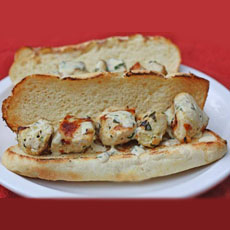
A chicken spiede. Here’s the recipe. Photo courtesy InspiredToCook.com. |
SPREAD
The purpose of the spread is to moisten both the bread and the filling. The most common are mayonnaise and mustard, but can also include barbecue sauce, cheese sauce, chutney, ketchup, steak sauce, tahini, yogurt sauce, and any number of other sauces, from horseradish to salsa.
|
SUBMARINE SANDWICH
Variously called a grinder, hoagie, hero, and torpedo in other regions, the submarine or sub has at least two claims to invention, and may have plausibly occurred in both places. One is in Boston at the beginning of World War I, made by a local restaurant that served Navy servicemen stationed at the Charlestown Navy Yard. The bread was a specially baked baguette intended to resemble the hull of the submarines it was named after. Another claim credits Dominic Conti (1874–1954), an Italian immigrant who started Dominic Conti’s Grocery Store on Mill Street in Paterson, New Jersey in 1910, and named the sandwich after seeing a recovered submarine in the Paterson museum Museum Of History in 1918.
|
|
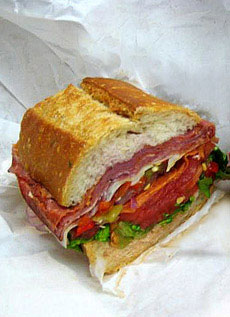
The all-American submarine sandwich. Photo courtesy Wikimedia Commons. |
Conti’s granddaughter recounts that he was selling traditional Italian sandwiches made on a long crusty roll, filled with cold cuts, lettuce, tomatoes, peppers, onions, oil, vinegar, Italian herbs, spices, salt and pepper. The sandwich started with a layer of cheese and ended with a layer of cheese so the bread wouldn’t get soggy. See also hero and hoagie.
National Submarine-Hoagie-Hero-Grinder Day is celebrated on October 9th.
The history of the submarine sandwich.
TAVERN SANDWICH
A variety of sloppy joe sandwich from the Midwest consisting of unseasoned sautéed ground beef and onions mixed on a bun. It can be topped with pickles, ketchup and mustard. It is also called a loosemeat or Maid-rite.
|
TEA SANDWICH
Tea sandwiches are small sandwiches initial created as bites to go with afternoon tea. They can be triangle, square or rectangle in shape, or can be cut into fanciful shapes (crescents, hearts, etc.) with a cookie cutter. The bread was traditionally white, thinly sliced, and buttered, with the crust removed. Contemporary variations might use the more modern whole wheat, pumpernickel, sour dough or rye breads. The fillings are light and delicate. Spreads might include cream cheese or mayonnaise mixtures or “protein” salads (crab, egg, ham, tuna).
|
|
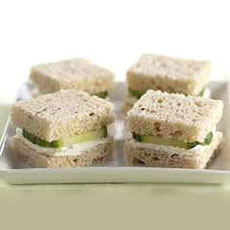
Tea sandwiches cut into squares. Photo courtesy Kraft Foods. |
The sandwiches often feature fresh vegetables such as asparagus, cucumber, radish or watercress. The cucumber tea sandwich, thickly sliced on buttered bread, is considered the quintessential tea sandwich. Other popular tea sandwich fillings include pimento cheese, smoked salmon, fruit jam and curried chicken and egg salads. Also see finger sandwich, a variety of tea sandwich cut into long rectangles.
The history of afternoon tea.
TOASTED CHEESE SANDWICH
See cheese toastie.
TORPEDO SANDWICH
See submarine sandwich, above.
|
TORTA
Perhaps Mexico’s favorite fast food, a torta is the Mexican version of a submarine sandwich, served on an oblong, crusty white sandwich roll (a torpedo-shaped bolillo or a round telera). It can be served hot or cold. Popular ingredients include grilled steak (carne asada), marinated pork (al pastor), fried pork (carnitas), fried fish (pescado), ham (jamón) and beef tongue (lengua). Garnish choices can include avocado, beans, cheese, chimichurri sauce, chipotle chiles, lettuce, jalapeño chiles, poblano chiles, salsa fresca, sour cream and tomato.
“Torta” means different things in the Spanish language. In Spain it can mean cake or omelet. In South America and the Philippines, it can be an egg dish.
|
|

A Mexican carne asada torta (photo © Bohack 2 | SmarterPix). |
|
TOSTADA
A tostada is the Mexican equivalent of an open-face sandwich, made on a crisp tortilla (tostada) instead of a slice of bread. You can add any protein, plus lettuce, tomatoes, onions, avocado, grated cheese, sour cream (crema) and cilantro; and can get creative with anything from corn kernels to pickled jalapeños.
VIETNAMESE SANDWICH
See bánh mì.
|
|
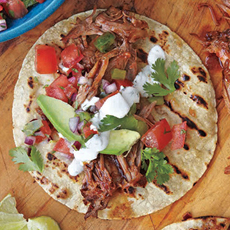
A pulled pork tostada. Photo courtesy Melissas.com. |
|
WAFFLE SANDWICH
Originally devised as a breakfast sandwich, replacing the toast on an egg sandwich with waffles, the waffle sandwich or wafflewich has evolved into a savory and sweet option for any meal of the day. Add eggs and sausage for breakfast, ham and cheese for lunch, ice cream and chocolate sauce for dessert. Here are recipes for Ham and Cheese and BLT Waffle Sandwiches.
|
|
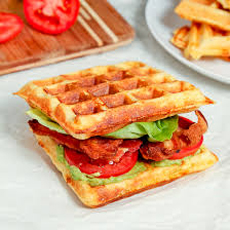
A Waffle BLT. Photo courtesy Elegant AffairsCaterers.com. |
|
WESTERN SANDWICH or DENVER
SANDWICH
Scrambled eggs or an egg omelet cooked with green peppers, ham and onions and served hot on toast or a roll. Some culinary historians believe that it was the invention of Chinese cooks who prepared it as a snack for cowboys: an egg foo young omelet between slices of bread. It is called a Western sandwich east of the Mississippi and a Denver sandwich in the west.
WRAP SANDWICH
A sandwich made by rolling standard sandwich fillings in a tortilla.
Go To The Article Index Above
|
|
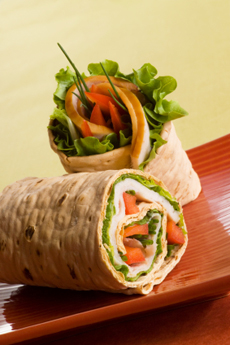
Wrap sandwich. Photo by Cloud Food | IST. |
Lifestyle Direct, Inc. All rights reserved. Photographs are the copyright of their respective owners.

|
















